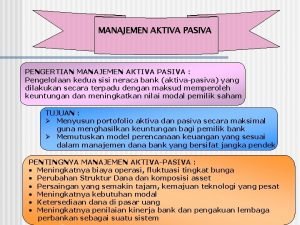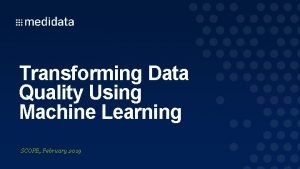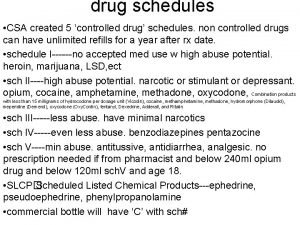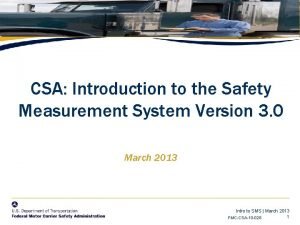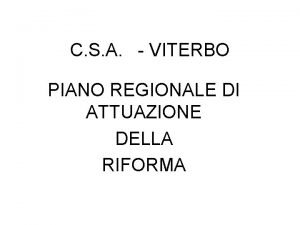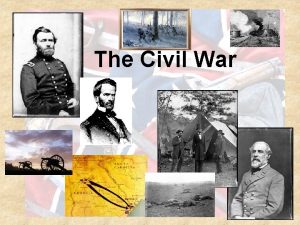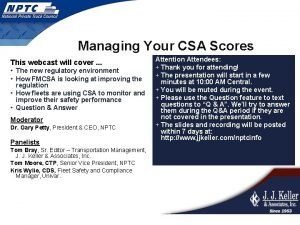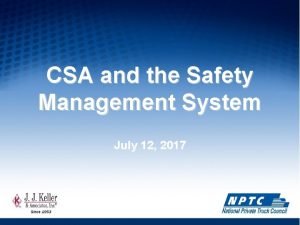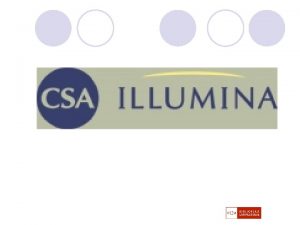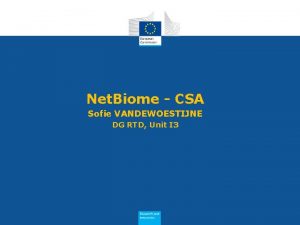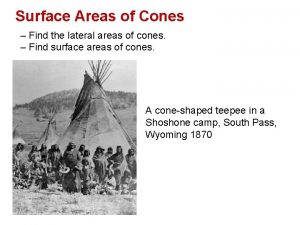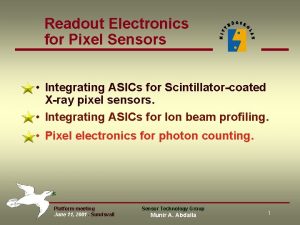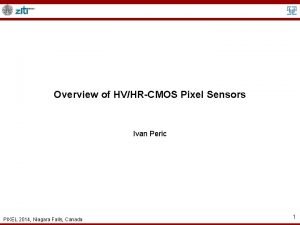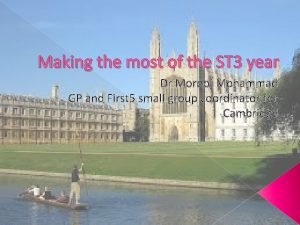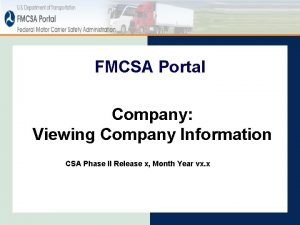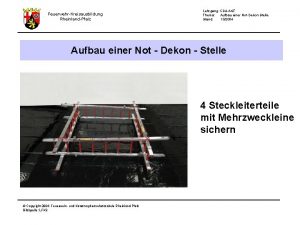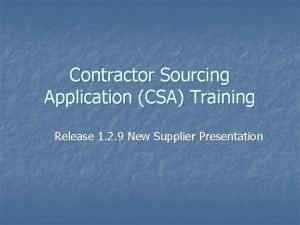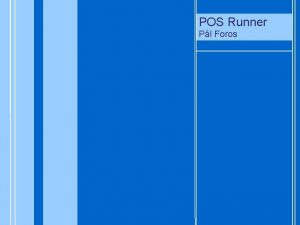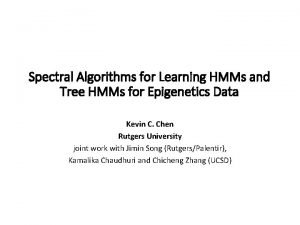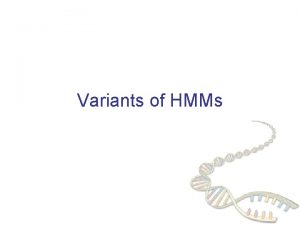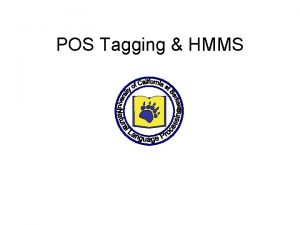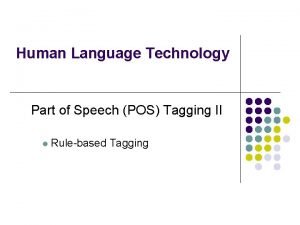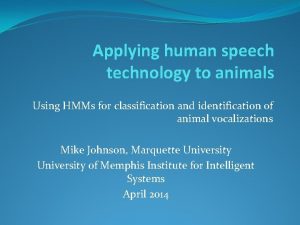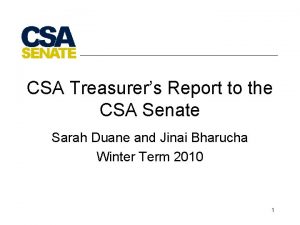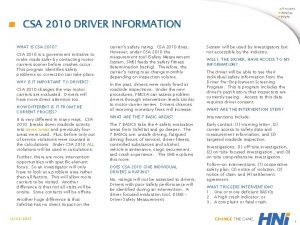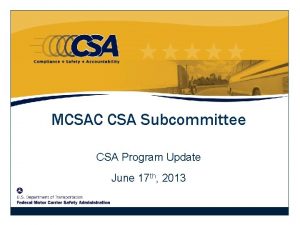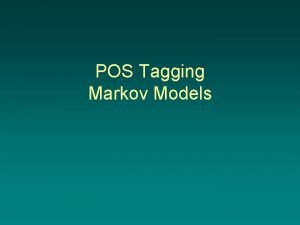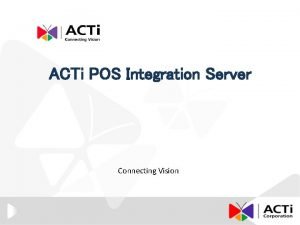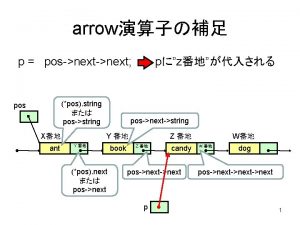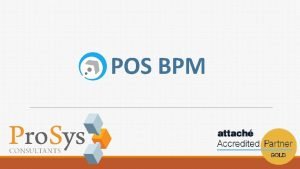CSA 3202 Human Language Technology HMMs for POS













































- Slides: 45

CSA 3202 Human Language Technology HMMs for POS Tagging 1

Acknowledgement § Slides adapted from lecture by Dan Jurafsky

Hidden Markov Model Tagging § Using an HMM to do POS tagging is a special case of Bayesian inference § Foundational work in computational linguistics § Bledsoe 1959: OCR § Mosteller and Wallace 1964: authorship identification § It is also related to the “noisy channel” model that’s the basis for ASR, OCR and MT 3

Noisy Channel Model for Machine Translation (Brown et. al. 1990) source sentence target sentence 4

POS Tagging as Sequence Classification § Probabilistic view: § Given an observation sequence O = w 1…wn § e. g. Secretariat is expected to race tomorrow § What is the best sequence of tags T that corresponds to this sequence of observations? § Consider all possible sequences of tags § Out of this universe of sequences, choose the tag sequence which maximises P(T|O) 5

Getting to HMMs § i. e. out of all sequences of n tags t 1…tn the single tag sequence such that P(t 1…tn|w 1…wn) is highest. § Hat ^ means “our estimate of the best one” § argmaxx f(x) means “the x such that f(x) is maximized” 6

Getting to HMMs § But how to make it operational? How to compute this value? § Intuition of Bayesian classification: § Use Bayes Rule to transform this equation into a set of other probabilities that are easier to compute 7

Bayes Rule 8

recall this picture. . A A B B sample space 9

Using Bayes Rule 10

Two Probabilities Involved: Probability of a word sequence given a tag sequence Probability of a tag sequence 11

Probability of tag sequence § We are seeking p(ti, . . . , t 1) = P(t 1|0) * p(t 2|t 1) * p(t 3|t 1, t 2)*, … , * p(ti|ti-1, …, t 1) (by chain rule of probabilities where 0 is the beginning of string) § Next we approximate this product … 12

Probability of tag sequence by N-gram Approximation § By employing the following assumption p(ti|ti-1, . . . , t 1) ≈ p(ti|ti-1) § i. e. we approximate the entire left context by the previous tag. So the product is simplified to P(t 1|0) * p(t 2|t 1) * p(t 3|t 2)*, … , * p(ti|ti-1) 13

Generalizing the Approach The same trick works for approximating P(wn 1|tn 1) ≈ P(w 1|t 1) * P(w 2|t 2) * P(wn-1|tn-1) * P(wn|tn) as seen on the next slide 14

Likelihood and Prior 15

Two Kinds of Probabilities 1. Tag transition probabilities p(ti|ti-1) 2. Word likelihood probabilities p(wi|ti) 16

Estimating Probabilities § Tag transition probabilities p(ti|ti-1) § Determiners likely to precede adjs and nouns § That/DT flight/NN § The/DT yellow/JJ hat/NN § So we expect P(NN|DT) and P(JJ|DT) to be high § Compute p(ti|ti-1) by counting in a labeled corpus: 17

Example 18

Two Kinds of Probabilities § Word likelihood probabilities p(wi|ti) § VBZ (3 sg Pres verb) likely to be “is” § Compute P(is|VBZ) by counting in a labeled corpus: 19

Example: The Verb “race” § Secretariat/NNP is/VBZ expected/VBN to/TO race/VB tomorrow/NR § People/NNS continue/VB to/TO inquire/VB the/DT reason/NN for/IN the/DT race/NN for/IN outer/JJ space/NN § How do we pick the right tag? 20

Disambiguating “race” 21

Example § § § § § P(NN|TO) =. 00047 P(VB|TO) =. 83 P(race|NN) =. 00057 P(race|VB) =. 00012 P(NR|VB) =. 0027 P(NR|NN) =. 0012 P(VB|TO)P(NR|VB)P(race|VB) =. 00000027 P(NN|TO)P(NR|NN)P(race|NN)=. 0000032 So we (correctly) choose the verb reading 22

Hidden Markov Models § What we’ve described with these two kinds of probabilities is a Hidden Markov Model (HMM) § We approach the concept of an HMM via the simpler notions § Weighted Finite State Automaton § Markov Chain 23

WFST Definition § A Weighted Finite-State Automaton (WFST) adds probabilities to the arcs § The sum of the probabilities leaving any arc must sum to one § A Markov chain is a special case of a WFST in which the input sequence uniquely determines which states the automaton will go through § Examples follow 24

Markov Chain for Pronunciation Variants 25

Markov Chain for Weather 26

Probability of a Sequence § Markov chain assigns probabilities to unambiguous sequences § What is the probability of 3 consecutive rainy days? § Sequence is rainy-rainy § I. e. , state sequence is 0 -3 -3 -3 § P(0, 3, 3, 3) = § 0 a 03 a 33 = 0. 2 x (0. 6)3 = 0. 0432 27

Markov Chain: “First-order observable Markov Model” § A set of states § Q = q 1, q 2…q. N; the state at time t is qt § Transition probabilities: § a set of probabilities A = a 01 a 02…an 1…ann. § Each aij represents the probability of transitioning from state i to state j § The set of these is the transition probability matrix A § Current state only depends on previous state 28

But. . § Markov chains can’t represent inherently ambiguous problems § For that we need a Hidden Markov Model 29

Hidden Markov Model § For Markov chains, the output symbols are the same as the states. § See hot weather: we’re in state hot § But in part-of-speech tagging (and other things) § The output symbols are words § But the hidden states are part-of-speech tags § So we need an extension! § A Hidden Markov Model is an extension of a Markov chain in which the input symbols are not the same as the states. § This means we don’t know which state we are in. 30

Hidden Markov Models § States Q = q 1, q 2…q. N; § Observations O= o 1, o 2…o. N; § Each observation is a symbol from a vocabulary V = {v 1, v 2, …v. V} § Transition probabilities § Transition probability matrix A = {aij} § Observation likelihoods § Output probability matrix B={bi(k)} § Special initial probability vector 31

Underlying Markov Chain is as before, but we need to add. . . 32

Observation Likelihoods 33

Observation Likelihoods § Observation likelihoods P(O|S) link actual observations O with underlying states S § Are necessary whenever there is not a 1: 1 correspondence between the two. § Examples from many different domains where there is uncertainty of interpretation § § OCR Speech Recognition Spelling Correction POS 34

Decoding § Recall that we need to compute § We could just enumerate all paths given the input and use the model to assign probabilities to each. § Many Paths § Only need to store the most probable path § Dynamic programming § Viterbi Algorithm 35

Viterbi Algorithm § Inputs § HMM § Q: States § A: Transition probabilities § B: Observation likelihoods § O: Observed Words § Output § Most probable state/tag sequence together with its probability 36

POS Transition Probabilities 37

POS Observation Likelihoods 38

Viterbi Summary § Create an array § Columns corresponding to inputs § Rows corresponding states § Sweep through the array in one pass filling the columns left to right using our transition probs and observations probs § Dynamic programming key is that we need only store the MAX prob path to each cell, (not all paths). 39

Viterbi Example 40

41

POS-Tagger Evaluation § Different metrics can be used: § Overall error rate with respect to a goldstandard test set. § Error rates on particular tags c(gold(tok)=t and tagger(tok)=t)/ c(gold(tok)=t) § Error rates on particular words § Tag confusions. . . 42

Evaluation § The result is compared with a manually coded “Gold Standard” § Typically accuracy reaches 96 -97% § This may be compared with result for a baseline tagger (one that uses no context). § Important: 100% is impossible even for human annotators. § Inter annotator agreement problem 43

Error Analysis § Look at a confusion matrix § See what errors are causing problems § Noun (NN) vs Proper. Noun (NNP) vs Adj (JJ) § Preterite (VBD) vs Participle (VBN) vs Adjective (JJ) 44

POS Tagging Summary § Parts of speech § Tagsets § Part of speech tagging § Rule-Based § HMM Tagging § Markov Chains § Hidden Markov Models § Next: Transformation based 45
 Hmms
Hmms Manajemen aktiva dan pasiva bank
Manajemen aktiva dan pasiva bank Medidata csa
Medidata csa Ap cs recursion
Ap cs recursion Csa schedules
Csa schedules Csaof cube
Csaof cube Csa basic thresholds
Csa basic thresholds Csa illumina
Csa illumina Csa viterbo
Csa viterbo Csa vs usa
Csa vs usa Gary petty sms
Gary petty sms Gary petty sms
Gary petty sms Como buscar el autor de una imagen
Como buscar el autor de una imagen Dg csa
Dg csa Ap csa
Ap csa Csa
Csa Csa notorious nine 2021
Csa notorious nine 2021 Area of hemisphere
Area of hemisphere Net of a come
Net of a come Rds.csa
Rds.csa Csa isda
Csa isda Csa tw75
Csa tw75 Csa tracking system
Csa tracking system Pennine vts
Pennine vts Fmcsa iss score
Fmcsa iss score Csa feuerwehr
Csa feuerwehr Ria ia csa
Ria ia csa Ibm csa login
Ibm csa login Features of human language
Features of human language Kontinuitetshantering
Kontinuitetshantering Typiska drag för en novell
Typiska drag för en novell Tack för att ni lyssnade bild
Tack för att ni lyssnade bild Ekologiskt fotavtryck
Ekologiskt fotavtryck Varför kallas perioden 1918-1939 för mellankrigstiden
Varför kallas perioden 1918-1939 för mellankrigstiden En lathund för arbete med kontinuitetshantering
En lathund för arbete med kontinuitetshantering Kassaregister ideell förening
Kassaregister ideell förening Tidbok för yrkesförare
Tidbok för yrkesförare Anatomi organ reproduksi
Anatomi organ reproduksi Vad är densitet
Vad är densitet Datorkunskap för nybörjare
Datorkunskap för nybörjare Stig kerman
Stig kerman Hur skriver man en debattartikel
Hur skriver man en debattartikel Autokratiskt ledarskap
Autokratiskt ledarskap Nyckelkompetenser för livslångt lärande
Nyckelkompetenser för livslångt lärande Påbyggnader för flakfordon
Påbyggnader för flakfordon Lufttryck formel
Lufttryck formel

